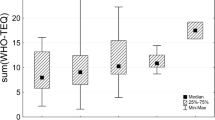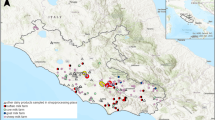Abstract
We report on the content of polychlorinated dibenzo-p-dioxins (PCDDs) and polychlorinated dibenzofurans (PCDFs) in 15 breast milk samples of nursing women living in the city of Taranto (Southern, Italy) or nearby. Breast milk samples were collected over the 2008–2009 period and analyzed by gas chromatography coupled with high-resolution mass spectrometry (GC-HRMS) upon accelerated solvent extraction (ASE) using acetone/n-hexane mixture 1:1 (v/v). The method was validated demonstrating good performing features. Profiles of PCDD/PCDF congeners in breast milk samples exhibited a prevalence of PCDFs compared to PCDDs. Toxic equivalents (TEQs in picogram per gram fat) of four breast milk were far above the legal limit for human consumption of 3.0 pg/g; their estimated daily and weekly dietary intake were almost 5–20 and 10–40 times higher, respectively, than the tolerable intake values established by the World Health Organization.

Occurrence of the toxic micropollutants in breast milk samples of mothers living in or nearby Taranto


Similar content being viewed by others
References
Ito S, Lee A (2003) Drug excretion into breast milk—overview. Adv Drug Deliv Rev 55:617–627
Heinig MJ (2001) Host defense benefits of breastfeeding for the infant: effect of breastfeeding duration and exclusivity. Pediatr Clin North Am 48:105–123
Fontcuberta M, Arqués JF, Villalbí JR, Martínez M, Serrahima E, Centrich F, Ábalos M, Abad E, Duran J, Casas C (2009) Surveillance of dioxins and polychlorinated biphenyls (PCBs) in food commercialized in Barcelona, Spain. Food Addit Contam B 1:66–73
Charnley G, Kimbrough RD (2006) Overview of exposure, toxicity, and risks to children from current levels of 2,3,7,8-tetrachlorodibenzo-p-dioxin and related compounds in the USA. Food Chem Toxicol 44:601–615
Fromme H, Albrecht M, Boehmer S, Büchner K, Mayer R, Liebl B, Wittsiepe J, Bolte G (2009) Intake and body burden of dioxin-like compounds in Germany: The INES study. Chemosphere 76:1457–1463
USEPA Method 1613 (1994) Revision B. Tetra- through octa-chlorinated dioxins and furans by isotope dilution HRGC/HRMS. U.S. Environmental Protection Agency Office of Water Engineering and Analysis Division (4303), 401 M Street S.W. Washington, D.C. 20460
Commission Regulation, Commission Regulation (EC) (2006) No. 1881/2006 of 19 December 2006. Setting maximum levels for certain contaminants in foodstuffs. Off J Eur Union L 364:5–24
Ulaszewska MM, Zuccato E, Davoli E (2011) PCDD/Fs and dioxin-like PCBs in human milk and estimation of infants' daily intake: a review. Chemosphere 83:774–782
Focant J-F, Pirard C, Thielen C, De Pauw E (2002) Levels and profiles of PCDDs, PCDFs and cPCBs in Belgian breast milk. Estimation of infant intake. Chemosphere 48:763–770
Ulaszewska MM, Zuccato E, Capri E, Iovine R, Colombo A, Rotella G, Generoso C, Grassi P, Melis M, Fanelli R (2011) The effect of waste combustion on the occurrence of polychlorinated dibenzo-p-dioxins (PCDDs), polychlorinated dibenzofurans (PCDFs) and polychlorinated biphenyls (PCBs) in breast milk in Italy. Chemosphere 82:1–8
Weiss J, Papke O, Bignert A, Jensen S, Greyerz E, Agostoni C, Besana R, Riva E, Giovannini M, Zetterstro R (2003) Concentrations of dioxins and other organochlorines (PCBs, DDTs, HCHs) in human milk from Seveso, Milan and a Lombardian rural area in Italy: a study performed 25 years after the heavy dioxin exposure in Seveso. Acta Paediatr 92:467–472
Dahl P, Lindström G, Wiberg K, Rappe C (1995) Absorption of polychlorinated biphenyls, dibenzo-p-dioxins and dibenzofurans by breast-fed infants. Chemosphere 30:2297–2306
WHO Regional Office for Europe (1996) Levels of PCBs, PCDDs and PCDFs in human milk: second round of WHO-coordinated exposure study. Environmental Health in Europe 3, Copenhagen
World Health Organization (2000) Consultation on assessment of the health risks of dioxins; re-evaluation of the tolerable daily intake (TDI): executive summary. Food Addit Contam 17:223–240
van den Berg M, van Birgelen A, Birnbaum L, Brouwer B, Carrier G, Conolly R, Dragan Y, Farland W, Feeley M, Fürst P, Galli C, de Gerlache J, Grieg J, Hayashi Y, Hayashi Y, Herrman J, Kogevinas M, Kurokawa Y, Larsen JC, Liem D, Luijckx L, Matsumura F, McGregor D, Mocarelli P, Moore M, Moy G, Newhook R, Ouane F, Peterson R, Poellinger L, Portier C, Rappe C, Rogan W, Schrenk D, Shkolenok G, Sweeney M, Tohyama C, Tuomisto J, Ueda H, Waters J, van de Wiel J, van Leeuwen FXR, Younes M, Zeilmaker M (2000) Revision of the tolerable daily intake of dioxin by WHO. Food Add Contam 17:223–240
Scientific Report of European Food Safety Authority (2010) EFSA J 8(3):1385–1421
Schecter A, Papke O, Lis A, Ball M, Ryan JJ, Olson JR, Li L, Kessler H (1996) Decrease in milk and blood dioxin levels over two years in a mother nursing twins: estimates of decreased maternal and increased infant dioxin body burden from nursing. Chemosphere 32:543–549
Schecter A, Ryan JJ, Papke O (1998) Decrease in levels and body burden of dioxins, dibenzofurans, PCBs, DDE, and HCB in blood and milk in a mother nursing twins over a thirty-eight month period. Chemosphere 37:1807–1816
Yang J, Shin D, Park S, Chang Y, Kim D, Ikonomou MG (2002) PCDDs, PCDFs, and PCBs concentration in breast milk from two areas in Korea: body burden of mothers and implications for feeding infants. Chemoshere 46:419–428
USEPA (2000) Exposure and human health reassessment of 2,3,7,8-tetrachlorodobenzo-p-dioxin (TCDD) and related compounds: part I estimating exposure to dioxin-like compounds. Properties, Environmental levels, and Background Exposure, vol. 3. (EPA/600/P-00/001Bc)
McLachlan MS (1993) Digestive tract absorption of polychlorinated dibenzo-p-dioxins, dibenzofurans, and biphenyls in a nursing infant. Toxicol Appl Pharmacol 123:68–72
Acknowledgments
Dr. Giuseppe Novario is acknowledged for his valuable assistance. This work was performed by using the instrumental facilities of CIGAS Center founded by EU (Project no. 2915/12), Regione Basilicata, and Università degli Studi della Basilicata.
Author information
Authors and Affiliations
Corresponding author
Electronic supplementary material
Below is the link to the electronic supplementary material.
ESM 1
(PDF 681 kb)
Rights and permissions
About this article
Cite this article
Bianco, G., Zianni, R., Anzillotta, G. et al. Dibenzo-p-dioxins and dibenzofurans in human breast milk collected in the area of Taranto (Southern Italy): first case study. Anal Bioanal Chem 405, 2405–2410 (2013). https://doi.org/10.1007/s00216-013-6706-7
Received:
Revised:
Accepted:
Published:
Issue Date:
DOI: https://doi.org/10.1007/s00216-013-6706-7




